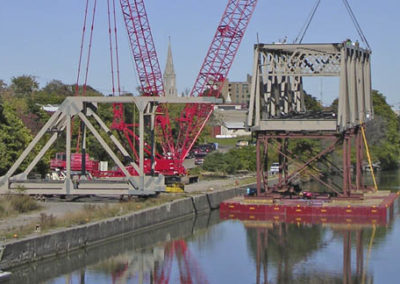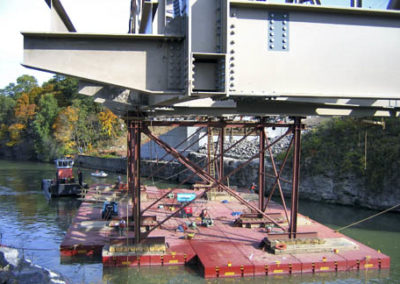Due to the presence of hazardous sediment at the bottom of the canal, the New York DOT restricted the contractor from using any construction method that would disturb the bottom, including temporary bents to support the span during construction. Compounding this problem, high-voltage lines crossing the canal adjacent to the location of the bridge precluded the use of cranes to support the trusses when positioning the 1.15 million pound structure.
With these restrictions, conventional construction methods would have been impractical. To solve the problem, the contractor consulted Robishaw Engineering to determine if it would be feasible to erect as much of the bridge as possible on Flexifloat modular pontoon barges, and then float the structure into place. After preliminary analysis, Robishaw’s engineers confirmed that the use of Flexifloats was a viable and effective solution. The contractor then selected Structural Engineering Concepts of Pittsburgh, Pennsylvania to identify the major sub-components, design the rigging and temporary shoring necessary to support the bridge above the barge and develop the jacking procedure to lower the bridge onto once it was positioned over the abutment seats.
Based upon the calculated loads, Robishaw Engineering designed and provided a rectangular Flexifloat assembly which would adequately support the bridge and shoring during the erection process. However, as the bridge would be situated at a 45-degree angle to the narrow canal, it later became apparent that the turning of the barge to place the bridge in position would result in the corners of the barge striking the canal banks before proper alignment could be achieved. To overcome this final obstacle, the modular Flexifloat pontoons were simply reconfigured into an approximate parallelogram, thereby permitting full rotation of the barge without interference.
In October of 2004, roughly five months after the steel erection process began, the bridge was ready to be moved into place. The operation went smoothly, taking only eight hours to position and lower the bridge on to temporary blocking at the abutments. Once the structure was resting on the blocking, several flotation sections were selectively ballasted and the entire barge and shoring were floated away from the site. Later, the 600-ton bridge was lowered on to the abutment seats using hydraulic jacks.
Here again, the strength, flexibility and versatility of the Flexifloat Construction System provided a compliant, safe and economical solution to the unique challenges of this project.
Additional information on this project may be found in an article written by John E. Christopher, Ph.D., P.E. in the June 2005 issue of Modern Steel Construction.



